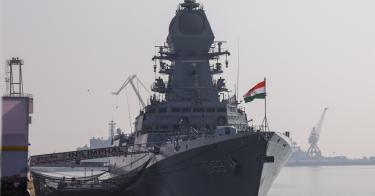Beijing’s undersea cable sabotage, gray-zone “fishing” militias, and expanding submarine patrols are surging across the Indo-Pacific. In response, Washington and New Delhi are quietly forging a high-tech partnership in maritime domain awareness (MDA) aimed at exposing and deterring these threats.
MDA refers to the ability to understand everything happening in the maritime space that could impact security, safety, trade, or the environment. It combines situational, threat, and response awareness built through a network of sensors and analysis of data from space, surface, sub-surface, and underwater sources.
For the United States and India, MDA cooperation includes real-time data sharing, joint surveillance, and other measures to strengthen each partner’s ability to monitor and respond to malign activities at sea. As China expands its naval reach across the Indo-Pacific, this cooperation is no longer optional; it is mandatory.
China’s Maritime Ambitions
China’s maritime activities are growing in scope and scale. Submarine deployments across the Indian Ocean are on the rise, as is the number of incidents involving suspected sabotage of undersea internet cables by China and Russia. In 2023, undersea internet cables connecting Taiwan to its offshore Matsu Islands were cut 12 times, according to Chunghwa Telecom. The repeated disruptions lasted weeks and cost over $2.9 million to repair.
While China denies involvement in these activities, the incidents fit a broader pattern. Beijing has increasingly leveraged civilian vessels to probe or disrupt maritime infrastructure, including commercial cable routes. These persistent and implausibly deniable actions reflect China’s use of grey-zone tactics to target digital lifelines beneath the waves.
At the same time, China makes use of civilian maritime vessels to expand its naval objectives. These “dual-use vessels” can serve military objectives under the guise of commercial or research activity. China’s vast maritime militia, comprising fishing boats, transport vessels, and auxiliary ships, operates under PLA command and plays a crucial role in advancing Beijing’s territorial claims without triggering open conflict.
>>> Pakistan’s Terror Challenge Isn’t Just India’s Problem
These ships conduct patrols, surveillance, and even harass foreign vessels, providing China with a low-cost, deniable tool to gain strategic space. This blurring of civilian and military roles complicates traditional threat detection, making maritime domain awareness a critical line of defense.
Strategic Waters and Chokepoints
Few nations sit astride more critical sea lanes than India. From the Andaman Sea and Bay of Bengal in the east, through the Strait of Malacca, to the Arabian Sea and approaches to the Horn of Africa in the west, India’s geography spans the Indo-Pacific’s busiest maritime corridors.
This geography includes chokepoints like the Strait of Malacca, which funnels roughly 23.7 million barrels of oil per day (nearly one-quarter of the global maritime oil trade) into East Asian energy markets, and the Strait of Hormuz, which handles about 20 million barrels per day (around 20 percent of the world’s supply). Additionally, the Bab el-Mandeb Strait, at the gateway of the Red Sea, carried approximately 8.6 million barrels daily in 2023.
Over 80 percent of world trade by volume travels by sea, with trillions of dollars’ worth of goods moving through these Indian Ocean routes. By virtue of its location, India can observe all of these chokepoints—a fact the United States is keenly aware of.
For Washington, partnering with India at this crossroads is highly cost-efficient. It extends America’s maritime “eyes and ears” into critical zones without the expense of new bases or constant U.S. patrols. For New Delhi, it means receiving world-class intelligence and surveillance technology on its own terms, bolstering India’s security while preserving its strategic autonomy.
In short, U.S.-India MDA cooperation is a force multiplier for both sides. It strengthens deterrence at a lower cost to the American taxpayer and enhances India’s capabilities without compromising independence.
MDA Is Already a Quiet Success Story
Hence, it is no surprise that MDA is already becoming an important area of U.S.-India defense cooperation. While most of India’s long-range maritime surveillance fleet is U.S.-made, including the P-8I Poseidon aircraft and MQ-9B drones, recent initiatives show momentum in technical and operational integration.
In April 2025, the United States approved the sale of the SeaVision platform to India. Developed by the U.S. Navy, SeaVision enables real-time vessel tracking and analysis, giving Indian operators sharper visibility over maritime movements.
Earlier this year, Bharat Dynamics Limited and Ultra Maritime signed a co-production agreement for sonobuoys. Sonobuoys are the eyes and ears of oceanic surveillance and are underwater sensors critical to anti-submarine warfare. This is one of the most critical and cutting-edge technologies in anti-submarine warfare. The fact that a U.S. company is willing to co-produce this with India is a testament to its trust in the relationship. Sonobuoys made in India are not only easily deployable but also can be offered to other friendly nations.
In space-based maritime surveillance, India is also expanding its capabilities through collaboration with U.S.-based HawkEye 360, which provides satellite-derived radio frequency (RF) data. The RF data from HawkEye will enhance India’s ability to detect dark ships through AIS triangulation, monitor covert activity, and build a more complete picture of the maritime domain and vessel activity.
On uncrewed systems, Mahindra Defence and Anduril Industries are collaborating on autonomous maritime systems for surveillance and denial missions. Separately, Liquid Robotics (a company owned by Boeing) has partnered with Indian startup Sagar Defence Engineering to co-produce Wave Glider autonomous surface vehicles for long-endurance maritime surveillance. These low-profile vehicles can operate at sea for weeks, providing a persistent layer of undersea domain awareness.
These commercial cooperation efforts are reinforced by India’s participation in the Quad’s Indo-Pacific Maritime Domain Awareness initiative, which focuses on real-time, unclassified data sharing across the region. Together, these moves reflect a growing commitment to building a shared, common, real-time, operational picture of the Indo-Pacific.
Looking Ahead
India has already approved an ambitious $3 billion space-based surveillance mission to enhance its national security architecture and launch 52 satellites over the next decade, with a focus on persistent land and maritime domain awareness. Twenty-one of these will be developed by the Indian Space and Research Organization (ISRO). The remaining 31 satellites will be built by Indian private companies, under the coordination of the Defense Space Agency and the National Security Council Secretariat.
The initiative is bold and necessary, but building a space-based MDA constellation takes time. In the interim, there is a major opportunity to bridge the gap through U.S.-India commercial collaboration.
U.S. companies lead globally in synthetic aperture radar, RF, and electro-optic and infrared satellite data and analytics. Their platforms already offer real-time maritime surveillance that is being used by navies and coast guards around the world. By licensing this data and enabling access, these firms can help India accelerate capability in the near term. Similarly, Indian private companies are well-positioned to fuse, analyze, and integrate this data into operational environments at scale.
To enable such ecosystems to take shape, the United States and India should establish a secure framework for space and sea-based data sharing. The two countries could establish a fortified, real-time information-sharing agreement for MDA, enabling them to exchange radar tracks, satellite feeds, and sonar data seamlessly. This pact should include encrypted networks, common operating pictures, and AI-driven analytics to flag potential threats.
>>> Now Is the Time To Advance Middle East Integration
Joint MDA exercises should also expand beyond interoperability drills. Future exercises should include simulations of gray-zone scenarios, such as undersea cable sabotage, AIS spoofing, and dark ship tracking, in contested waters.
Both nations should also invest in co-developing advanced sensors for next-generation maritime sensing and unmanned systems. This could include deploying passive acoustic networks and autonomous underwater vehicles (AUVs) across high-risk corridors to detect submarines and mines.
Finally, MDA must go regional. The United States and India should invite other friendly Indo-Pacific nations to plug into a broader MDA sharing network. Building on the Quad’s IPMDA, Washington and New Delhi should co-train regional partners in using MDA tools and establish fusion centers to distribute maritime intelligence. A distributed, coalition-wide sensor network stretching from the Strait of Malacca to the Horn of Africa would blanket the Indo-Pacific, complicating any adversary’s hostile plans.
Visibility Is Power
You can’t deter what you can’t see. Investing in maritime domain awareness offers a high return on investment by extending U.S. surveillance reach via allied assets in a cost-effective manner. In the Indian Ocean, better visibility starts with India. For India, this cooperation boosts defense without eroding sovereignty. And for the entire region, it promises a more secure and stable maritime order.
Maritime domain awareness may not grab headlines, but it is a key component of modern warfare and fast becoming the backbone of operational trust between the United States and India. As China’s reach expands across the Indo-Pacific, the United States and India must see clearly and see together.
This piece originally appeared in The National Interest



